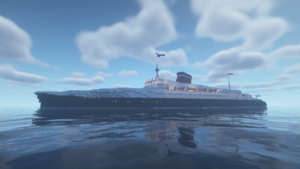Royal Caprican Line
| Royal Caprican Line | |
|---|---|
| Basic info | |
| CEO | Tonster_ |
| Founded | 1936 (lore) |
| Type | Passenger oceanic line |
| Other info | |
| Ships in fleet | 4 |
| Cities served | N/A |
| Headquarters | Caprica |
The Royal Caprican Line (RCL) is a trans-oceanic passenger line founded in 1936 that operated from Caprica. The company once ran services to areas such as Miu Wan, Bahia, and Nansei-Gunto, but are now responsible for their last owned ship, the hotel ship SS Hermes.
History
The line was founded in 1936 in Caprica, with the aim of getting the most market share out of the small, growing city. The first liner RCL purchased was the RMS Empress of Southoak from Aqua Star Line, a ship first built back nearly 20 years before in 1918, and renamed it to the SS Aphrodite. Aphrodite first entered service on May 22, 1936 from Caprica to Miu Wan. She averaged 22 knots on the journey, and was made more for shorter trips. She was put on the Shenghua route in the winter season of 1936/1937 after being fitted with better engines, boosting her speed to 24kt.
RCL gained enough money from the old and slow Aphrodite to order a newer, faster ship. The keel of the SS Caprica was laid down in mid-1937, and she finished her sea trials in August 1939, averaging a whopping 37 knots, 15 more than Aphrodite. She initially went down to Shenghua on September 4, 1939, before trying her hand at the Southern Cross on September 18, the award for the fastest ship between Nansei-Gunto and Bahia. On September 21, she arrived in Sunshine Coast after a trip of 3 days, 4 hours, and 42 minutes, beating the previous record-holder by almost 18 hours. She achieved the westbound Southern Cross on her way back to Shenghua on September 30-October 2, 1939. Passengers described Caprica as the most comfortable ship on the seas.
Caprica became so successful that she made back four times her cost in the 1940 season alone, on top of beating the Southern Cross record twice after her first crossing. A sister, SS Ares, entered service in late 1942, averaging only 35 knots - she was never able to achieve the Southern Cross.
In 1949, RCL decided to build a much larger ship than any other ship. The keel of the SS Hermes was laid down in 1950, she was finished in 1952, went out for sea trials in October 1952, and entered service in Feb 1953, out of Caprica. A documentary titled SS Hermes: The Giant Of The Seas was filmed on board her maiden voyage to Bahia, plus her return trip. Hermes weighed over 20,000 tons and became the largest passenger vessel in the world.
On a sad note, Aphrodite was sold to scrap in 1972, followed by Ares in 1975. The advent of airliners had killed off most ocean lines. Caprica was sold off in 1979 to an unknown buyer, who renamed her SS Wenyanga. Wenyanga foundered while traveling between Caprica and Wenyanga. Her wreck is visible today, having been eroded by winds over 40+ years. Hermes continued to operate cruises through the 80s, but was laid up in 1987. In 1992, after failing to find a buyer, the ship was reopened as a hotel/attraction, with the aim of growing land and development around. Hermes has been a hotel ship since then, the last remaining ship of the Royal Caprican Line.
Fleet
| Ship | Years | GRT | Picture |
|---|---|---|---|
| Aphrodite | 1936-1972 | ||
| Caprica | 1939-1979 | ||
| Ares | 1942-1975 | ||
| Hermes | 1953- | 
|